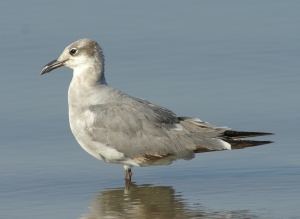Background
Arlington Reservoir lies between Lewes and Hailsham in East Sussex, and is designated as a Site of Special Scientific Interest (SSSI). It was completed in 1971, and sits in the Cuckmere Valley, just north of where the river cuts through the South Downs.
The reservoir supplies drinking water to a large area of East Sussex including Hailsham, Polegate and Eastbourne, and is also home to a trout fishery.
Its 49-hectare surface area is attractive to birds of open water, particularly to migrants using the Cuckmere Valley, and much of the surrounding countryside is rich in wildlife.
Birds
In winter, home to a mooted 10,000+ or more, but most of the time the reservoir is much quieter. Numbers are highest at either end of the day during the winter season, when Canada Geese and gulls make up the majority of birds present. A wide variety of common duck may aso occur, particularly Wigeon, though generally numbers are small. Divers, grebes and scarcer ducks are sometimes recorded, but rarely stay long.
Grey Herons, Cormorants and a few Little Egrets may be encountered at any time of year. The number of Great Crested Grebes usually peaks in the autumn, but double figures can be seen most of the year
It’s quite possible to visit the reservoir and fail to see a wader, but a wide variety have occured, particularly at times when the water level is low.
Most likely to be encountered are Lapwing, Redshank, Dunlin, Common and Green Sandpiper, with Ringed and Little Ringed Plovers fairly regular, and Little Stints a speciality in early autumn.
The selection of songbirds around the reservoir in spring and early summer can be very good, including at least seven species of migrant warbler, Nightingale and Turtle Dove. Traditionally the dense scrub on the north shore, near the hide, is good, as is the vicinity of the water treatment works near the river.
From spring until autumn there is a chance of Osprey, but they generally only visit the reservoir to hunt, disappearing into nearby woodland to eat their prey; so luck is required to see one.
Other common raptors are recorded regularly; the pylons viewable in the fields to the North are good for Peregrine, and Hen Harrier is recorded most years.
The now-ubiquitous Common Buzzard may be seen anywhere, but is most likely to be over Abbot’s Wood to the East, which is worth scanning with a telescope for Raven , Osprey and other birds of prey.
Although the southern side of the reservoir is fringed with concrete, it attracts some waders and wagtails (Grey and Pied all year, Yellow in spring and autumn), and the long line of fence nearby can be good for picking up migrants such as Whinchat and Wheatear, and resting hirundines.
The damp pasture and scrub to the south and east of the reservoir is good for Barn Owl all year, migrant warblers and Nightingale in summer, Snipe in winter, and recently Cetti’s Warbler. The area near the waterworks is good all year for Grey Wagtail, as well as for the aforementioned Turtle Dove and warblers during spring and summer.
The area around the car park is good for a range of common woodland/garden birds, such as the common finches, Coal Tit, Mistle Thrush and Green Woodpecker, plus Reed Bunting, Reed Warbler (summer) and occasionally Brambling (winter).
Rarities since 2000 have included Red-rumped Swallow (5+), Alpine Swift, Spoonbill, Laughing Gull, Bonaparte’s Gull, Temminck’s Stint and Buff-breasted Sandpiper.
Other widlife
Notable non-bird records in the SSSI and surrounding area include dormouse, great crested newt and glow-worm.
The grassland just north of the car park is particularly noted for its selection of butterflies in the summer season.
Access
Access by rail and bus is fairly easy: alight at Berwick Station and walk a third of mile along the road until you see the entrance to Arlington Reservoir on the right.
By car, park along the road running north from Berwick Station or in the main car park (there’s a charge). Walk North East along the perimeter path to the get to the hide, or south past the fishing lodge to view the dam end. It takes about 1.5 hours, including short stops for birds, to walk around the whole reservoir.
Alternatively, the eastern side of the reservoir can be accessed from the village of Arlington.
Links
East Sussex CC leaflet – Arlington Reservoir Walk
Citation for Arlington Reservoir’s status as an SSSI
Map of Arlington Reservoir (Google Maps)
Nearby birding sites
Bo Peep (Alciston)
Abbot’s Wood, Arlington
Glynde Levels
Lower Cuckmere valley
This page prepared by Charlie Peverett, with Les Bird and Paul C Stevens, November 2009, updated October 2010






